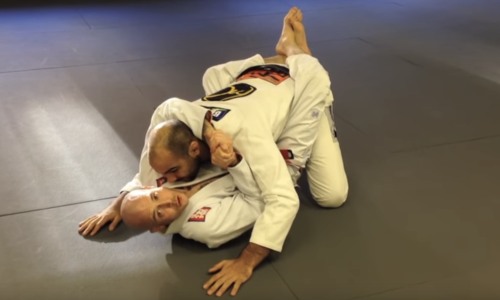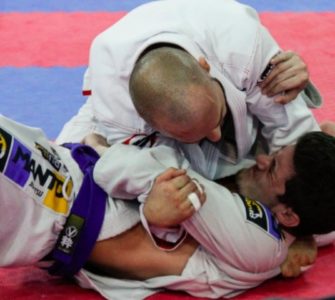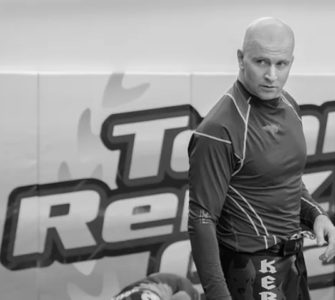The closed guard is often times the first position a beginner Jiu Jitsu practitioner learns about and starts practicing. Therefore, in the next couple of White Belt Advice articles, we’ll take a look into this fundamental position.
To begin, in this article we’ll look into the very basics of what makes this type of a guard work. For the sake of simplicity, let’s do that in four separate parts: what a „guard“ is; the closed guard’s defensive purpose; its offensive purpose; and, finally, how to position your body in the closed guard.
WHAT, A GUARD? WHO AM I GUARDING?
Alright, first things first – what is a guard?
In simple terms, a guard in BJJ is when one jiujiteiro has his back on the ground and tries to control his opponent by using his own legs.
And how are the legs used to control the opponent, exactly? They’re used in two principal ways: to either keep the opponent away from you and out of your reach (done by posting your feet onto him and pushing him away – this is a fundamentally defensive position), or to keep your opponent close to you and within your reach (by crossing your legs across his body; or, more fundamentally, his waist – this is an essentially offensive position).
Guess which of these two positions is called the closed guard? That is correct; it is the second one (whereas the first one is the open guard – don’t worry, we’ll get into it in the following series of articles).
Let’s first take a look into the defensive purpose of the closed guard.
CLOSED GUARD’S DEFENSIVE PURPOSE: CONTROL
In Brazilian Jiu Jitsu, it all comes down to getting yourself into a more dominant position versus your opponent and then submitting him with a certain technique. For this to be successful, you first need to pass the opponent’s guard.
In other words, you must not let him control you with his legs. This is done by passing them – getting their legs out of your way – and then getting into a dominant position.
If, on the other side, you’re on the receiving end of this – if you’re playing defense and trying to get somebody into your own guard – then the closed guard is a great option to strive towards.
Why so? Simply said: it is quite difficult to “escape” it. That is, because you are keeping your opponent close to yourself by wrapping your legs around him (and positioning the hips correctly, together with your hands – which we’ll talk about later on), he does not have enough space to freely move his body. This, in turn, makes it difficult for him to pass you and establish himself into a more favorable, dominant position.
This is the essence of the closed guard’s defensive purpose: you are controlling your opponent in a relatively secure position, making it very difficult for him to move and threaten you. He has nowhere to go; and, what’s more, finds himself in a threat of being submitted.
And yes, you’ve read that correctly! It is exactly this defensive purpose that actually turns the closed guard into a position of offense – for, since you are controlling your opponent and since you are not in much of a danger yourself, you can start threatening him instead.
CLOSED GUARD’S OFFENSIVE PURPOSE: BREAKING THE POSTURE
So, what we’ve learned is that the defensive purpose of the closed guard opens up a window of opportunity to play offense. You are in a relatively secure position, controlling your opponent; it makes it possible for you to set up a whole series of submission attempts and sweeps, something which we’ll be looking at in subsequent articles.
But, what’s the basics of it all? What makes the closed guard into such a strong offensive position and, actually, how do you start setting up all of those submission and sweep attempts?
The answer to all of this is (*drumroll*): breaking the posture.
The posture is superbly important in Jiu Jitsu. The way you position your body – more specifically, your head and back – is what will hugely impact the quality of your game. This also means that posture will dictate how vulnerable you’ll be to submissions, sweeps and takedowns.
By focusing on keeping your head and neck upright, and your back straight, it will be much more difficult for your opponent to sweep you and/or submit you.
Come on, just think about it: do you feel more powerful when your shoulders are slouched back and your head looking at the floor? Or is it when you are upright?
Now, give it a shot on the mats as well – start standing with your partner and get him to pull you down to the floor, while your back is rounded and your head is pointing down. Then, have him do the same while your spine is straight and your head upright… Was he more successful in the first or second case?
The same thing is applicable in closed guard. If you can make your opponent round his back and, by doing so, get him to lose his upright position, then you have effectively broken his posture down. Then, you can start engaging him with sweeps and/or attacks with more ease than you could’ve done otherwise.
Therefore, let’s use this crucial principle – the principle of breaking your opponent’s posture – to better understand the most important starting point: the proper body positioning in closed guard.
BODY POSITIONING IN THE CLOSED GUARD
Closed guard is, despite what it might look as at the first glance, not just about „crossing your feet“ and „staying there“. Instead, if done correctly, it is a very active position that asks for all of the required body parts to be placed in the right position and in a right fashion.
So, let’s take look at each of these body parts – the legs/feet, hips and hands – and explain how you should place them. As mentioned, in order for you to understand it better; we’ll do so both through the lens of a more passive closed guard approach (when you are, simply, „holding it“), as well as when you are actively engaging the opponent in it – trying to break his posture and attack him.
Don’t worry yourself about the possible details of the upcoming points. We’ll look at them with more detail in the following articles, which will deal with closed guard sweeps, submissions and escapes.
Just focus on these basics for now.
Legs Positioning
As said, the closed guard is not as simple as crossing your legs and feet around your opponent. To place them correctly, you need to do two things:
1) When in more of a passive position, your heels need to go down, as low as they can be on the opponent’s backside. This makes it possible for you not just to engage your legs more – because this sort of a positioning asks for more of an active „squeeze“ with your legs then just mindlessly crossing them does – but it also engages your hips more (take a look at the „Hip Positioning“ part below), which is extremely important for having a good closed guard.
2) When breaking the posture, pull with your legs. If you are looking to break your opponent’s posture, don’t try to do so by pulling them towards you with your arms. You will tire yourself out by doing so and you will often find that it wasn’t too successful.
Instead, focus on pulling them with your legs. This is done in almost a reverse-crunch fashion, where your knees pull them towards you. However, there’s an another important point while you are doing that, and it is to…
3) … climb your legs higher. Simply said: the legs don’t just pull, but your feet go up explosively towards their shoulder blades and your knees pull towards you at the same time.
How to do this? Just imagine that you’re trying to hit them in the back of their head with your crossed feet, in the same time as you are pulling them towards you. Practice doing that a couple of times and you will see how much easier it is to get their posture down.
Hips Positioning
„It is all in the hips“ is a phrase that you will hear quite often in BJJ. And nothing will ever be more true than that, as your hips will always play a crucial factor in the success of your game. The same is with the closed guard.
And what’s the most important thing to remember with hip positioning in the closed guard? It is that your hips should always be active.
What this means is that:
1) Your hips should not be glued to the ground, but need to be off of it. This allows you to freely move them at all times.
2) Your hips should never be square with your opponent’s hips, as this is not as pragmatic for breaking their posture – and it makes them comfortable. You don’t want them to be comfortable. Which means that you need to…
3) … create different angles with your hips at all times. Paired with the other two points, this will have your opponents on their tippy-toes, as you are constantly threatening to break their posture and to set them up for all sort of sweeps and attacks from multiple different directions.
Hands/Grips Positioning
The most fundamental thing to know, so as to what you should do with your hands in the closed guard, is that they should always be fighting for the grips. And why? It’s because the way you place your grips will determine how successful of a sweep or submission you will be able to set up.
While there are many possible variations of grip placement out there – depending on a multitude of factors, all the way from being in a gi or without a gi; towards the specifics of the sweep/submission you want to set up – we’ll focus on the two most important points of contact, which will be true in almost all situations:
1) Neck control: in order to control your opponent’s neck, variations of the collar grip or direct head control are used most often.
2) Arm control: most often, you will be placing your grips by their sleeve or on their wrist, as well as behind their elbow.
Therefore, the easiest hand placement to learn and use in the closed guard would be to have one of your grips on the opponent’s sleeve or grabbing his wrist, while the other one is controlling his collar.
Don’t think about this too much for now. Just keep in mind that having the grips in the right place will make your opponent more prone to attacks.
—
Well, there you have it. Now you know what a „guard“ is, what the closed guard’s primary purposes are, and how to position yourself in the closed guard properly; with an additional knowledge on how to break your opponent’s posture.
Until the next article – in which we’ll go into more detail on how to set up sweeps in the closed guard – watch the video below by Otavio Sousa. The visual details will make it easier for you to understand what makes the closed guard work and on how to break the posture.
Closed guard is going to be one of the first guards that you learn, and one of the last that you master. There are so many sweeps, submissions, grip combinations, and options from the closed guard. Learning closed guard will assist you in developing a strong foundation to build the rest of your bjj around. If you want to learn some extremely high level attacks from the closed guard, check out 5x World Champion, Bernardo Faria’s 4 DVD set, “The Closed Guard.”




















